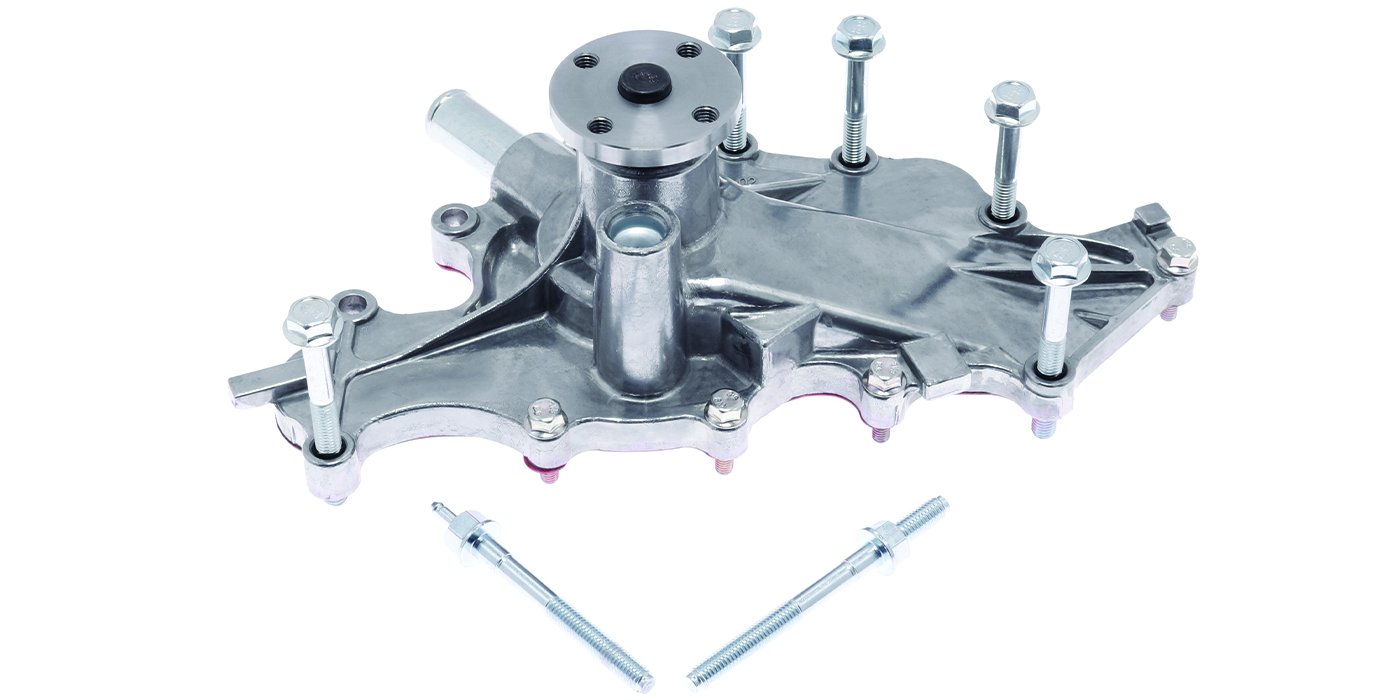Some Honda owners may complain of a chirp from the lower timing belt area. The noise is most often noticed at idle, usually after the engine has warmed up. The probable cause is the idler pulley mounting surface is tilted, causing the edge of the timing belt to rub against the side of the pulser flange on the drive pulley (gear).
Corrective Action:
Install a taper shim kit, and grind a deeper relief on the engine mount bracket, if needed.
These 2007 Accord V6 vehicles also require water pump replacement:
• 2-Door with M/T – From VIN 1HGCM8 …7A002002 through 1HGCM8…7A004104
• 2-Door with A/T – From VIN 1HGCM8 …7A002029 through 1HGCM8…7A003983
• 4-Door with M/T – From VIN 1HGCM6 …7A037354 through 1HGCM6…7A060259
• 4-Door with M/T – From VIN 1HGCM6 …7A034807 through 1HGCM6…7A057992
Applicable Models:
2005-’08 Accord V6, Odyssey and Pilot, and 2006-’08 Ridgeline
Required Parts and Materials:
Taper Shim Kit:
• 2005 models: P/N 04148-RCA-305
• 2006-’08 models: P/N 04148-RCA-306
(Contains taper shim, timing belt and timing belt drive pulley gear)
Water Pump (2007 Accord V6 only): P/N 19200-RDM-A02
Hondalock 1 (or equivalent): (one container repairs about 10 vehicles): P/N 08713-0001
Diagnosis:
1. Confirm the noise present at idle with a warm engine.
2. Shut off the engine and remove the accessory drive belt.
3. Start the engine. Do you still hear the noise?
Yes – Go to Repair Procedure.
No – Reinstall the drive belt, and then continue with normal accessory drive belt troubleshooting procedures. Make sure there is no more noise coming from the accessory drive belt before proceeding.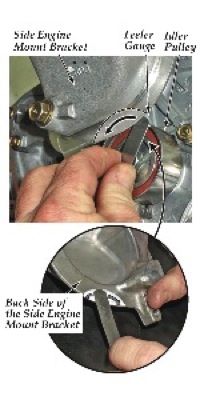
Repair Procedure:
Note: On certain 2007 Accord V6 vehicles, you will also be replacing the water pump (see Corrective Action). All other non-water pump replacement steps apply to all affected vehicles.
1. Affected 2007 Accord V6 only: Drain the engine coolant into a clean container, and save it for reuse.
2. Set the engine to TDC (top dead center).
3. Remove the crankshaft pulley.
4. Remove the timing belt covers.
5. Try to insert a 0.95 mm feeler gauge between the top edge of the timing belt idler pulley and the back of the side engine mount bracket overhanging the pulley. This measurement is used to determine if step 12 is required (see Fig. 1).
Note: Remove the feeler gauge from its holder to get a more accurate measurement.
6. Unbolt the CKP (crankshaft position) sensor (if applicable), and set it aside. Do not disconnect the CKP harness connector.
7. Remove the engine mount bracket.
8. Remove the timing belt.
9. Affected 2007 Accord V6 only: Remove the timing belt adjuster.
10. Affected 2007 Accord V6 only: Remove the water pump.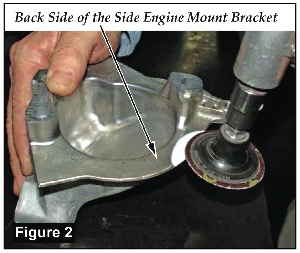
11. Remove the timing belt idler pulley.
12. If the feeler gauge did fit in step 5, go to step 13. If the feeler gauge did not fit in step 5, remove the side engine mount bracket. Using a die grinder with a 2-in., 50-grit grinding disc (or equivalent) and the circular casting offset as a guide, grind the side engine mount bracket until the lip measures 2 mm thick with a caliper or micrometer (see Fig. 2).
13. Affected 2007 Accord V6 only: Replace the water pump, and reuse the coolant you removed in step 1.
14. Affected 2007 Accord V6 only: Reinstall the timing belt adjuster.
15. Place the idler pulley shim between the idler pulley and the oil pump housing, and loosely install the idler pulley bolt with Hondalock 1 applied to its threads. Make sure to follow the assembly instructions on the Hondalock 1 container (see Fig. 3).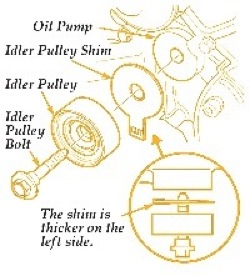
Note: The shim tapers from left to right. The word “OUT” is painted in white and stamped into the tang of the shim, and should be readable when the shim is installed.
16. When tightening the idler pulley bolt, use the square end of a 1/4-in. drive ratchet extension to keep the shim’s tab in the correct position. After you tighten the idler pulley bolt to 44 Nm (33 lb.-ft.), bend the shim’s tab slightly toward the oil pump housing to keep it away from the idler pulley (see Fig. 4).
17. Install a new timing belt drive pulley (gear).
18. Install a new timing belt. Note: Use the (new belt) Timing Belt Replacement Procedure, not (used belt) Timing Belt Installation Procedure.
19. Reinstall the CKP sensor (if applicable), and torque its bolt to 9.8 Nm (7.2 lb.-ft.).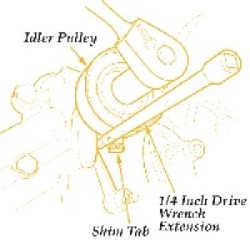
20. Reassemble the remaining parts using the appropriate service manual procedures. If you replaced the water pump, make sure you bleed any air from the cooling system after refilling with the coolant you drained in step 1.
21. Do the CKP pattern clear/CKP pattern learn procedure. Go to the appropriate procedure below.
Note: If you don’t do the CKP pattern clear/learn procedure, the PCM may detect a misfire when there is none, and possibly set DTC(s) P0300 through P0306.
CKP Pattern Clear/Learn Procedure
2005-’06 Odyssey and 2005 Pilot
Note:
• The ECT must be at least 176° F (80° C).
• 2005 Pilot only: Before doing this procedure, check “PULSER F/B LEARN” and “PULSER F/B LEARN (HIGH RPM)” in the DATA LIST with the HDS. If both values show N/A, this procedure is not needed.
• 2005 Pilot only: If only “PULSER F/B LEARN (HIGH RPM)” shows N/A, skip steps 7 through 9.
1. With the engine stopped, clear the CKP pattern.
2. Turn the ignition switch to LOCK (0).
3. Turn the ignition switch to ON (II), and wait 30 seconds.
4. Test-drive the vehicle on a level road. Decelerate with the throttle fully closed from an engine speed of 2,500 rpm to 1,000 rpm with the A/T in 2.
5. Stop the vehicle, but keep the engine running.
6. Check PULSER F/B LEARN in the DATA LIST with the HDS. If it is NOT COMPLETED, go to step 4. If it is COMPLETED, go to step 7.
7. Test-drive the vehicle on a level road. Decelerate with the throttle fully closed from an engine speed of 5,000 rpm to 3,000 rpm with the A/T in 2.
8. Stop the vehicle, but keep the engine running.
9. Check the PULSER F/B LEARN (HIGH RPM) in the DATA LIST with the HDS. If it is NOT COMPLETED, go to step 7. If it is COMPLETED go to step 10.
10. Turn the ignition switch to LOCK (0).
11. Turn the ignition switch to ON (II), and wait 30 seconds. The CKP learning procedure is complete.
2005-’ 08 Accord, 2007-’08 Odyssey, 2006-’08 Pilot and 2006-’08 Ridgeline
1. Connect the HDS to the data link connector (DLC) located under the driver’s side of the dashboard.
2. Turn the ignition switch to ON (II).
3. Make sure the HDS communicates with the ECM/PCM. If it does not, go to DLC circuit troubleshooting.
4. Select CRANK PATTERN in the ADJUSTMENT MENU with the HDS.
5. Select CRANK PATTERN LEARNING with the HDS, and follow the screen prompts.
6. Test-drive vehicle to confirm repair and relearn procedure.
Written by Chris Burton, ALLDATA Editor, and Jeff Webster, ALLDATA Technical writer.












